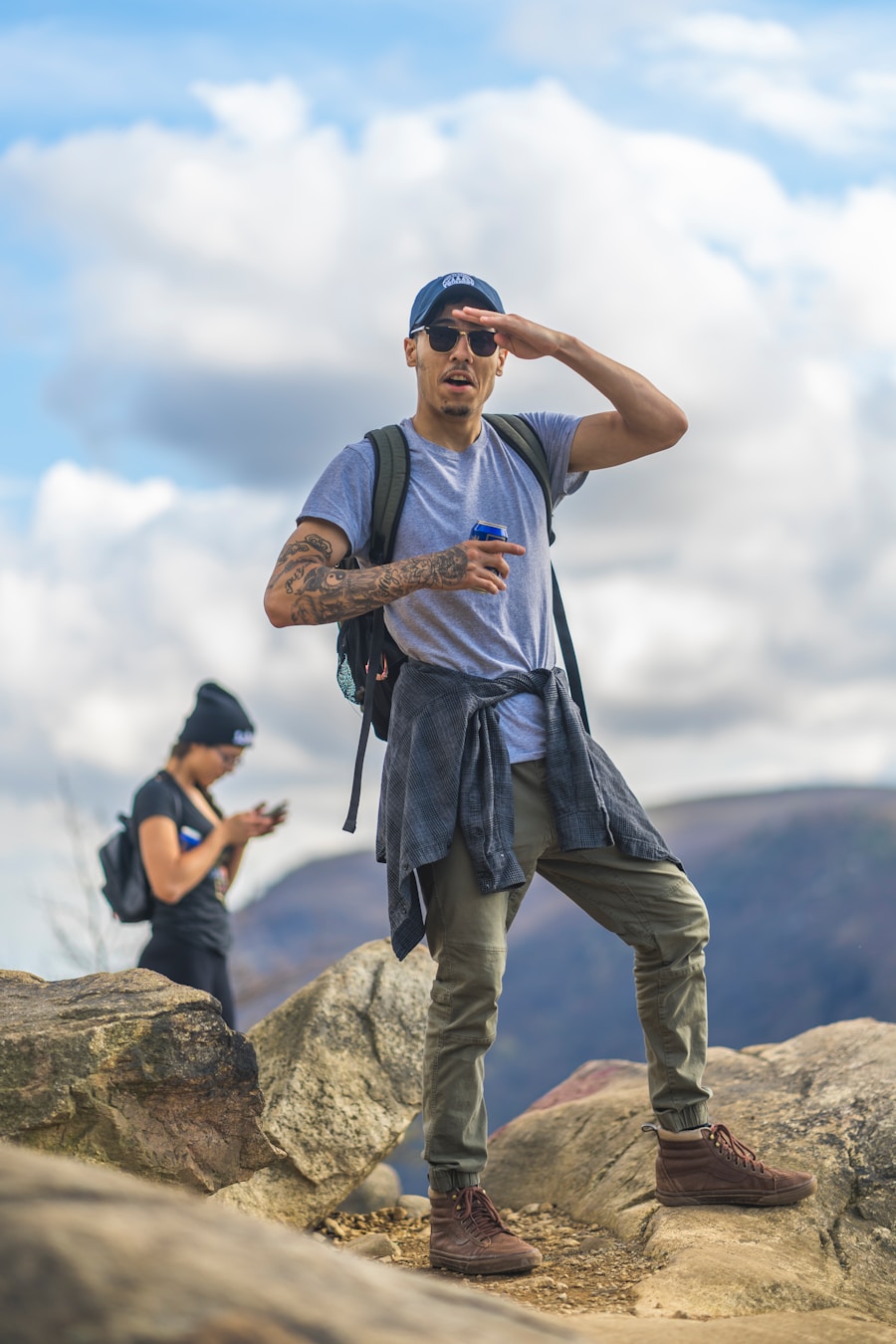Selecting the appropriate hiking boots is a critical decision that can significantly impact your outdoor experience. The right footwear not only provides comfort but also ensures safety on various terrains. Hiking boots come in a variety of styles, materials, and features, each designed to cater to different hiking conditions.
For instance, if you plan to tackle rugged trails with steep inclines, a boot with a sturdy sole and excellent ankle support is essential. Brands like Merrell and Salomon offer models specifically engineered for challenging terrains, featuring Vibram outsoles that enhance grip and stability. Moreover, the fit of your hiking boots cannot be overstated.
A well-fitted boot should allow for some wiggle room in the toes while providing a snug fit around the heel to prevent blisters. It’s advisable to try on boots at the end of the day when your feet are slightly swollen from daily activities, as this will give you a more accurate sense of how they will feel during a hike. Additionally, consider the type of socks you will wear; thicker socks may require a larger boot size.
Remember that breaking in your boots before embarking on a long hike is crucial; wearing them on shorter walks can help identify any pressure points or discomfort.
Key Takeaways
- Choosing the right hiking boots is crucial for comfort and preventing injuries on the trail.
- Lightweight and breathable clothing options are essential for staying cool and comfortable during summer hikes.
- Hats, sunglasses, and sunscreen are necessary for protecting against sunburn and heat exhaustion during outdoor adventures.
- Proper hydration with water bottles, hydration packs, and electrolyte supplements is key for maintaining energy and preventing dehydration on long hikes.
- When choosing a backpack, consider the right size and features to comfortably carry all necessary gear for hiking.
Clothing: Lightweight and Breathable Options for Summer Hiking
When it comes to summer hiking, choosing the right clothing is paramount for comfort and performance. Lightweight and breathable fabrics are essential to keep you cool and dry as temperatures rise. Materials such as moisture-wicking polyester or merino wool are excellent choices because they draw sweat away from the skin, allowing for quick evaporation.
This is particularly important during strenuous hikes where perspiration can lead to discomfort and chafing. Brands like Columbia and Patagonia offer a range of summer hiking apparel designed with these features in mind. In addition to moisture management, consider the importance of layering.
A lightweight base layer can help regulate body temperature, while a breathable mid-layer can provide insulation during cooler moments, such as early mornings or shaded areas on the trail. Furthermore, opting for clothing with UPF (Ultraviolet Protection Factor) ratings can offer additional sun protection, which is crucial during long hikes under direct sunlight. Lightweight, long-sleeved shirts and convertible pants can provide versatility, allowing you to adapt to changing weather conditions while minimizing the risk of sunburn.
Sun Protection: Hats, Sunglasses, and Sunscreen for Outdoor Adventures

Sun protection is an often-overlooked aspect of outdoor adventures, yet it plays a vital role in ensuring a safe and enjoyable experience. Wearing a wide-brimmed hat can shield your face and neck from harmful UV rays while also providing shade for your eyes. Look for hats made from breathable materials that allow for airflow, which is especially important during hot summer hikes.
Brands like Outdoor Research and Tilley offer hats designed specifically for outdoor activities, featuring moisture-wicking sweatbands and adjustable chin straps for a secure fit. Sunglasses are another essential component of sun protection. Not all sunglasses are created equal; it’s crucial to choose a pair that offers 100% UV protection to safeguard your eyes from long-term damage.
Polarized lenses can reduce glare from reflective surfaces like water or wet rocks, enhancing visibility on bright days. Additionally, applying sunscreen with a high SPF is imperative for exposed skin areas. Look for water-resistant formulas that can withstand sweat and moisture, ensuring lasting protection throughout your hike.
Reapplying sunscreen every two hours or after swimming is essential to maintain its effectiveness.
Hydration: Water Bottles, Hydration Packs, and Electrolyte Supplements
| Product | Capacity (oz) | Material | Price |
|---|---|---|---|
| Water Bottle A | 24 | Stainless Steel | 19.99 |
| Water Bottle B | 32 | Plastic | 12.99 |
| Hydration Pack A | 70 | Nylon | 49.99 |
| Hydration Pack B | 100 | Polyester | 79.99 |
| Electrolyte Supplement A | – | Powder | 24.99 |
| Electrolyte Supplement B | – | Tablet | 14.99 |
Staying hydrated during hikes is crucial for maintaining energy levels and overall health. The choice between water bottles and hydration packs often depends on personal preference and the length of the hike. Water bottles are straightforward and easy to refill at water sources along the trail; however, they can be cumbersome to carry if you’re hiking for extended periods.
On the other hand, hydration packs offer hands-free convenience with built-in reservoirs and tubes that allow you to sip water without stopping. Brands like CamelBak specialize in hydration packs that come in various sizes and styles, catering to different hiking needs. In addition to water intake, replenishing electrolytes is vital during strenuous hikes, especially in hot weather when you lose salts through sweat.
Electrolyte supplements in the form of tablets or powders can be added to your water to restore balance and prevent dehydration-related issues such as cramps or fatigue. Many outdoor enthusiasts prefer electrolyte drinks that not only hydrate but also provide essential nutrients like potassium and magnesium. It’s advisable to plan your hydration strategy before hitting the trail; knowing how much water you’ll need based on the hike’s duration and intensity can help prevent dehydration.
Backpacks: Choosing the Right Size and Features for Hiking
Selecting the right backpack is essential for carrying your gear comfortably while hiking. The size of the backpack should correspond with the length of your hike; day hikes typically require smaller packs ranging from 15 to 30 liters, while multi-day treks may necessitate larger packs of 50 liters or more. When choosing a backpack, consider features such as adjustable straps, padded hip belts, and ventilation systems that enhance comfort during long treks.
Brands like Osprey and Deuter offer backpacks designed with ergonomic features that distribute weight evenly across your body. Additionally, pockets and compartments play a significant role in organization during hikes. Look for backpacks with external pockets for easy access to items like water bottles or snacks without having to dig through the main compartment.
Some backpacks also come equipped with hydration reservoir sleeves, allowing you to carry water efficiently while keeping your hands free. Furthermore, consider weather-resistant materials or built-in rain covers if you anticipate encountering wet conditions on your hike; this will help protect your gear from unexpected downpours.
Navigation: Maps, Compasses, and GPS Devices for Trail Exploration

Topographic Maps: Understanding Elevation Changes
Topographic maps are particularly useful for hikers as they illustrate elevation changes that can impact trail difficulty. In addition to maps, compasses serve as reliable navigation tools when used correctly. A compass can help orient your map and provide direction when trails are poorly marked or obscured by dense foliage.
GPS Technology: Convenience and Limitations
However, modern technology has introduced GPS devices and smartphone applications that offer real-time navigation capabilities. Devices like Garmin’s handheld GPS units provide accurate positioning even in remote areas where cell service may be unavailable. While GPS technology is convenient, it’s crucial to have backup navigation methods in case of battery failure or device malfunction.
Importance of Backup Navigation Plan
It is essential to have a backup plan in place in case your primary navigation tool fails. This can include bringing a physical map, compass, and knowing how to use them. By having a backup plan, you can ensure a safe and enjoyable hiking experience.
Safety Gear: First Aid Kits, Whistles, and Emergency Supplies
Safety should always be a top priority when embarking on outdoor adventures. Carrying a well-stocked first aid kit is essential for addressing minor injuries such as cuts, scrapes, or insect bites that may occur on the trail. A comprehensive first aid kit should include adhesive bandages, antiseptic wipes, gauze pads, adhesive tape, pain relievers, and any personal medications you may need.
Many outdoor retailers offer pre-packaged kits designed specifically for hiking emergencies; however, customizing your kit based on your specific needs is advisable. In addition to first aid supplies, carrying emergency gear such as whistles can be invaluable in situations where you need to signal for help or alert others to your location. A whistle is lightweight and easy to carry but can be heard over long distances compared to shouting.
Other emergency supplies may include a multi-tool for various tasks, a flashlight or headlamp for visibility after dark, and a space blanket for warmth in case of unexpected weather changes or emergencies.
Extras: Insect Repellent, Trekking Poles, and Portable Snacks for Long Hikes
When preparing for long hikes, it’s important not to overlook additional items that can enhance your experience and comfort on the trail. Insect repellent is essential in areas where mosquitoes or ticks are prevalent; these pests can not only be annoying but also pose health risks through bites that may transmit diseases like Lyme disease or West Nile virus. Look for repellents containing DEET or natural alternatives like lemon eucalyptus oil that provide effective protection without harsh chemicals.
Trekking poles are another valuable addition to your hiking gear; they provide stability and support on uneven terrain while reducing strain on your knees during descents. Adjustable trekking poles allow you to customize their height based on your preference or terrain conditions. Many hikers find that using poles improves their balance and endurance over long distances.
Finally, packing portable snacks is crucial for maintaining energy levels throughout your hike. High-energy foods such as trail mix, energy bars, or jerky provide quick fuel when you need it most. Opting for lightweight options ensures that you won’t be weighed down by heavy snacks while still having enough sustenance to keep you going on longer treks.
Preparing snacks ahead of time allows you to choose healthier options tailored to your dietary preferences while ensuring you have enough energy reserves for your adventure ahead.
When planning what to wear hiking in the summer, it’s important to also consider the best power bank for international travel. A reliable power bank can keep your devices charged while you’re out on the trails, ensuring you can capture all the beautiful moments along the way. For more travel tips and recommendations, check out TakeTravelInfo. Additionally, if you’re looking for the perfect gift for a female traveler in your life, be sure to explore the list of the best travel gifts for her on TakeTravelInfo.
FAQs
What should I wear for hiking in the summer?
In the summer, it’s important to wear lightweight and breathable clothing that provides sun protection. Opt for moisture-wicking materials to keep you dry and comfortable.
What type of shirt is best for summer hiking?
A moisture-wicking, lightweight, and breathable shirt is ideal for summer hiking. Look for options with built-in sun protection and ventilation features.
What kind of pants are suitable for summer hiking?
For summer hiking, choose lightweight and quick-drying pants or shorts. Consider options with UPF protection and plenty of pockets for convenience.
What are the best footwear for summer hiking?
Sturdy and comfortable hiking boots or trail shoes are recommended for summer hiking. Look for options with good traction and support to navigate various terrains.
What accessories should I consider for summer hiking?
Accessories such as a wide-brimmed hat, sunglasses, sunscreen, and a hydration pack or water bottle are essential for summer hiking. Additionally, consider wearing moisture-wicking socks and using trekking poles for added stability.
Are there any specific clothing items to avoid for summer hiking?
Avoid wearing cotton clothing for summer hiking as it retains moisture and can lead to discomfort and chafing. Additionally, steer clear of heavy and non-breathable fabrics that can cause overheating.
